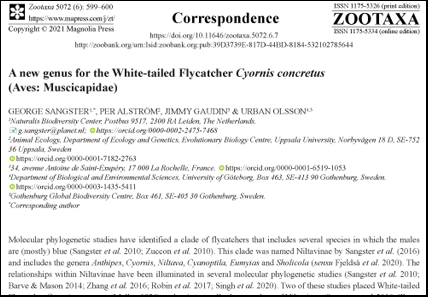Jim LeNomenclatoriste
Je suis un mignon petit Traquet rubicole

Chyi Yin Gwee, James A Eaton, Kritika M Garg, Per Alström, Sebastianus (Bas) Van Balen, Robert O Hutchinson, Dewi M Prawiradilaga, Manh Hung Le & Frank E Rheindt. (2019). Cryptic diversity in Cyornis (Aves: Muscicapidae) jungle-flycatchers flagged by simple bioacoustic approaches. Published: 10 Marsh 2019.
Abstract
Despite the ongoing taxonomic revolution incorporating multiple species delimitation methods, knowledge gaps persist in the taxonomy of comparatively well-studied animal groups such as birds. Morphologically cryptic species risk slipping under the conservation radar, as they get mistakenly united with other species. Here, we employed six to 11 vocal parameters of each population to examine the species delimitation of nine Cyornis jungle-flycatcher species complexes distributed across Asia. We found moderate to strong vocal evidence for the taxonomic elevation of ten cryptic Cyornis species. Additionally, we conducted mitochondrial and genome-wide SNP analyses for two of the Cyornis complexes to examine the effectiveness of bioacoustics as a tool for avian species delineation and found congruent results between vocal and molecular data. Therefore, we propose a taxonomic reclassification of the complicated Cyornis species complexes and recommend routine application of bioacoustics in avian taxonomic classification.
https://academic.oup.com/zoolinnean...innean/zlz003/5372980?redirectedFrom=fulltext
A short-lived happiness and a long taxonomic revision
Abstract
Despite the ongoing taxonomic revolution incorporating multiple species delimitation methods, knowledge gaps persist in the taxonomy of comparatively well-studied animal groups such as birds. Morphologically cryptic species risk slipping under the conservation radar, as they get mistakenly united with other species. Here, we employed six to 11 vocal parameters of each population to examine the species delimitation of nine Cyornis jungle-flycatcher species complexes distributed across Asia. We found moderate to strong vocal evidence for the taxonomic elevation of ten cryptic Cyornis species. Additionally, we conducted mitochondrial and genome-wide SNP analyses for two of the Cyornis complexes to examine the effectiveness of bioacoustics as a tool for avian species delineation and found congruent results between vocal and molecular data. Therefore, we propose a taxonomic reclassification of the complicated Cyornis species complexes and recommend routine application of bioacoustics in avian taxonomic classification.
https://academic.oup.com/zoolinnean...innean/zlz003/5372980?redirectedFrom=fulltext
A short-lived happiness and a long taxonomic revision










